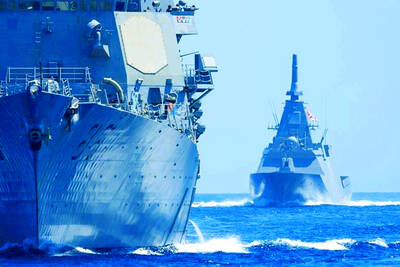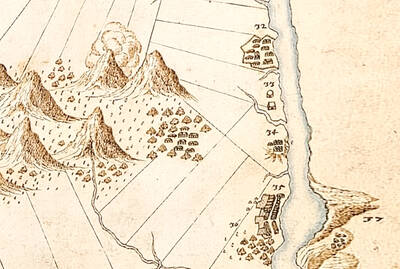It is probably appropriate to applaud the fact that Formosa Betrayed has been given a Taiwan release, but virtually everything else about the film can only make one shake one’s head. Causes for despair range from accusations of political pressure brought to bear on the production of the film, already given coverage recently in the Taipei Times (see stories on Page 3 of this newspaper’s July 31 and Aug. 2 editions), to the lamentable quality of the adaptation and filmmaking.
It is only fair to say that many, though far from all, of the problems in Formosa Betrayed can be attributed to the fact that it had to be shot in Thailand rather than Taiwan because of budget constraints that purportedly were the result of political pressure brought to bear by several members of the Chinese Nationalist Party (KMT), which is unsympathetically represented in the film.
Formosa Betrayed is loosely inspired by the book of the same title published in 1965 by George H. Kerr, a US Foreign Service staff officer in Taipei at the time of the 228 Incident in 1947. The book is a mixture of history and memoir that examines the events around the retrocession of Taiwan to Chinese rule and America’s not altogether honorable role in the process. The betrayal of the title refers not just to the dashing of hopes raised by the prospect of Taiwan being returned from Japanese colonial rule to administration by a Chinese government, but also the support given to a dictatorial regime by Washington, which ignored the democratic aspirations of the Taiwanese people for its own geopolitical interests. This provides background in the same way as Rajiv Chandrasekaran’s Imperial Life in the Emerald City: Inside Iraq’s Green Zone provides background for the Paul Greengrass action thriller Green Zone. In other words, it uses the book as little more than a bit of topical color.
Formosa Betrayed tells the story of Special Agent Kelly (James Van Der Beek), a junior officer with the FBI who gets sent to Taiwan to observe an investigation into the murder of Henry Wen, an outspoken critic of the KMT government who was assassinated while in exile in the US. Kelly quickly realizes that attempts to smear Wen as a triad member caught up in a gangland dispute are merely cover for a wide-ranging campaign of political terror by the KMT to silence anti-government elements. He decides to take things into his own hands, bucking the reigns that both his hosts and his superiors in the US try to put on him in order to bring the truth to light. He finds an ally in Ming (Will Tiao), who wants to get Taiwan’s message out to the world, and pays a terrible price.
Unfortunately, director Adam Kane is no Greengrass, and James Van Der Beek is no match for Matt Damon as an action hero, and the result is a plodding attempt at a political thriller that spends too much time on expository dialogue and fails to deliver any thrills. In addition to being shot in Thailand, the film uses no Taiwanese actors in any major role (Will Tiao is Taiwanese American and was born and raised in Kansas). This gives the film an utterly ersatz feel from the get-go, for the setting is manifestly not Taipei (and could not mistaken for it by anyone familiar with Taiwan even given the time lapse of 50 years). The facade is further compromised by the use of Chinese dialogue, as when Hong Kong-born US-based actor Tzi Ma, playing the role of a senior government official, gives a formal welcome speech at an official banquet for the newly arrived American agent in Mandarin so stilted that it would not be out of place in a speech contest for beginner students at National Taiwan Normal University’s Mandarin Training Center. The rest of the Chinese dialogue is of a piece with this. Although setting and sound might be secondary to the importance of getting a political message out to a wider audience, the poor quality of both seriously undermines the credibility of the film.
As for the political message, even that ends up getting hopelessly garbled, and director Kane gets caught up in the lockstep of the Hollywood mainstream thriller format. The complex ethnic and political issues surrounding Retrocession get reduced to a generic conflict of good, ordinary people turning against a corrupt and despotic power, and the lone man of conscience appalled by the self-interest of the government he serves. There is nothing here that stands out, either in the story or in the characters involved. The indifferent acting and flaccid dialogue don’t help.
The sad fact is that to get an idea about what was happening in Taiwan around Retrocession and the 228 Incident, there is still no rival for Hou Hsiao-hsien’s (侯孝賢) A City of Sadness (悲情城市), which was made way back in 1989. The best that can be said of Formosa Betrayed is that it might direct a few people to read the book, which is available online at www.romanization.com/books/formosabetrayed. Save your money and go online.

The Nuremberg trials have inspired filmmakers before, from Stanley Kramer’s 1961 drama to the 2000 television miniseries with Alec Baldwin and Brian Cox. But for the latest take, Nuremberg, writer-director James Vanderbilt focuses on a lesser-known figure: The US Army psychiatrist Douglas Kelley, who after the war was assigned to supervise and evaluate captured Nazi leaders to ensure they were fit for trial (and also keep them alive). But his is a name that had been largely forgotten: He wasn’t even a character in the miniseries. Kelley, portrayed in the film by Rami Malek, was an ambitious sort who saw in

It’s always a pleasure to see something one has long advocated slowly become reality. The late August visit of a delegation to the Philippines led by Deputy Minister of Agriculture Huang Chao-ching (黃昭欽), Chair of Chinese International Economic Cooperation Association Joseph Lyu (呂桔誠) and US-Taiwan Business Council vice president, Lotta Danielsson, was yet another example of how the two nations are drawing closer together. The security threat from the People’s Republic of China (PRC), along with their complementary economies, is finally fostering growth in ties. Interestingly, officials from both sides often refer to a shared Austronesian heritage when arguing for

Among the Nazis who were prosecuted during the Nuremberg trials in 1945 and 1946 was Hitler’s second-in-command, Hermann Goring. Less widely known, though, is the involvement of the US psychiatrist Douglas Kelley, who spent more than 80 hours interviewing and assessing Goring and 21 other Nazi officials prior to the trials. As described in Jack El-Hai’s 2013 book The Nazi and the Psychiatrist, Kelley was charmed by Goring but also haunted by his own conclusion that the Nazis’ atrocities were not specific to that time and place or to those people: they could in fact happen anywhere. He was ultimately

Nov. 17 to Nov. 23 When Kanori Ino surveyed Taipei’s Indigenous settlements in 1896, he found a culture that was fading. Although there was still a “clear line of distinction” between the Ketagalan people and the neighboring Han settlers that had been arriving over the previous 200 years, the former had largely adopted the customs and language of the latter. “Fortunately, some elders still remember their past customs and language. But if we do not hurry and record them now, future researchers will have nothing left but to weep amid the ruins of Indigenous settlements,” he wrote in the Journal of